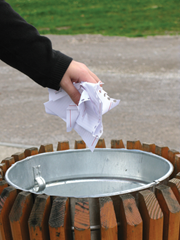Aiming for zero waste
 Andy Bond explains May Gurney’s approach to waste management, based on the aim of having no waste.
Andy Bond explains May Gurney’s approach to waste management, based on the aim of having no waste.
The overall point of waste management is having no waste, according to Andy Bond. May Gurney Environmental Services’ Development Director was speaking at agendaNi’s waste management seminar. The Norwich- based company delivers services for councils in England and Wales.
Pointing to Scotland and Wales’ ambitious targets, Andy Bond emphasised that this is a case where more can be delivered for less money, along with the desired environmental outcomes.
“There is an absolute correlation between the amount of containment we’ve given the public to put waste in and the amount of waste that we’ve got,” he added, pointing out that this was true when wheelie bins expanded in the 1980s and also true with recycling today.
It was essential, in his view, to design high frequency recycling systems and make sure people had enough space to store waste for recycling. Separating garden and food waste also helps. At the same time, storage space for residual waste (i.e. going to landfill) must be restricted. Bond also advocates a cap on the amount of waste being sent to mechanical biological treatment or incineration.
WRAP has found that in most local authorities, kerbside sorting systems offer “reliable material quality and lower net costs for council taxpayers.” Bond concurs and points to Somerset, which was the first area where May Gurney’s operating system (MaGOS) brought about a major change in amount of waste.
This scheme, in 2004-2005, resulted in the lowest residual waste in the UK at that time i.e. 162kg per capita. This fell to 130kg per capita in two districts. Across the area, 150kg less residual waste per person was collected.
Interviewed afterwards, he explained that most local authorities were paying nearly £100 a tonne for disposal so every tonne avoided completely saves them £100.
Bridgend Council, in Wales, had saved £2 million i.e. £33 per household per annum. More locally, he was impressed with Castlereagh Borough Council’s trial to collect dry recycling and food waste together on same vehicle weekly.
“The main challenge is the logistics of changing the systems,” he remarked. “Often you’re going from weekly refuse to alternate weekly refuse. You’re quite often taking away bin size, giving people smaller wheelie bins at the same time.”
Local authorities also needed to introduce change in bite-sized tranches e.g. changing a quarter of Belfast at a time rather than all at once.
Systems choice is key for success, in his view i.e. smaller wheelie bins collected less frequently, and providing more than one box to capture all the dry recyclates.
“Food waste collected weekly at the same time but separate from garden waste really focuses the mind of the public on how much we’re wasting food, and they change their behaviour.”
Good communication must support systems design. As 70 per cent recycling is achievable, he thinks people should be focusing on the next target. In May Gurney’s best performing schemes, capture rates for paper and glass are over 90 per cent and “we can nudge that up to close to 100.” Textiles are only around 50 per cent so there is certainly room for improvement in that category.
“We’ve got great results but we can target specific things, and if we can get everything up to the best, then we’ve got 90 per cent capture rates across the board.”
100 per cent is not possible but the mid- 90s are “really stretching what’s really possible,” he concludes.





